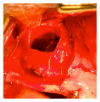The Maxillary Sinus Membrane Elevation Procedure: Augmentation of Bone around Dental Implants without Grafts-A Review of a Surgical Technique
- PMID: 22754569
- PMCID: PMC3383004
- DOI: 10.1155/2012/105483
The Maxillary Sinus Membrane Elevation Procedure: Augmentation of Bone around Dental Implants without Grafts-A Review of a Surgical Technique
Abstract
Background. Long-term edentulism may in many cases result in resorption of the alveolar process. The sinus lift procedure aims to create increased bone volume in the maxillary sinus in order to enable installation of dental implants in the region. The method is over 30 years old, and initially autogenous bone grafts were used and later also different bone substitutes. Since 1997, a limited number of studies have explored the possibility of a graftless procedure where the void under the sinus membrane is filled with a blood clot that enables bone formation. Aim. To describe the evolution of the sinus-lift technique and to review the literature related to the technique with a focus on long-term studies related to the graft-less technique. Methods. The electronic database PubMed was searched, and a systematic review was conducted regarding relevant articles. Results. A relatively few long-term studies using the described technique were found. However, the technique was described as reliable considering the outcome of the existing studies. Conclusion. All investigated studies show high implant survival rates for the graftless technique. The technique is considered to be cost-effective, less time-consuming, and related to lower morbidity since no bone harvesting is needed.
Figures




References
-
- Ellegaard B, Kølsen-Petersen J, Baelum V. Implant therapy involving maxillary sinus lift in periodontally compromised patients. Clinical Oral Implants Research. 1997;8(4):305–315. - PubMed
-
- Asai S, Shimizu Y, Ooya K. Maxillary sinus augmentation model in rabbits: effect of occluded nasal ostium on new bone formation. Clinical Oral Implants Research. 2002;13(4):405–409. - PubMed
-
- Johansson B, Grepe A, Wannfors K, Hirsch JM. A clinical study of changes in the volume of bone grafts in the atrophic maxilla. Dentomaxillofacial Radiology. 2001;30(3):157–161. - PubMed
-
- Tatum OH. Lecture presented to the Alabama Implant Congress. 1976.
-
- Boyne PJ, James RA. Grafting of the maxillary sinus floor with autogenous marrow and bone. Journal of Oral Surgery. 1980;38(8):613–616. - PubMed
LinkOut - more resources
Full Text Sources

